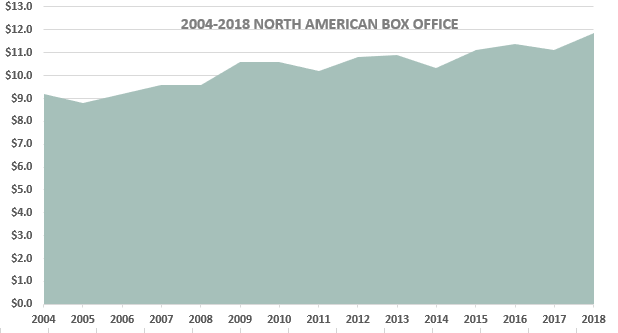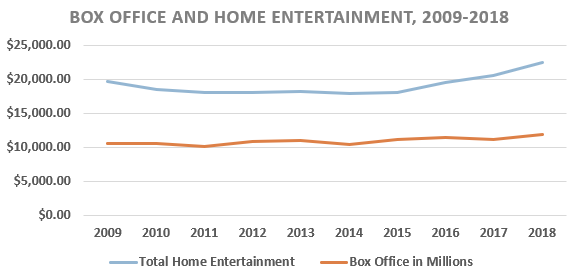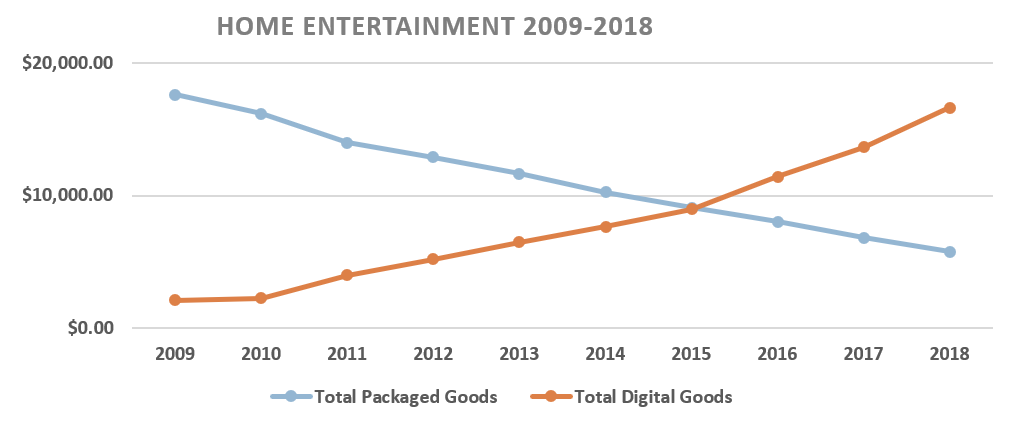Box Office Returns to Form in 2018
In late 2017, the biggest story was whether box office was falling off of a cliff or not, after the somewhat disastrous Summer and weak Fall season we discussed in last year’s Box Office Panic! series.
We’ve Seen This Before
We witnessed this same kind of slump back in 2005, when the box office fell from 2004’s $9.22 billion to 2005’s $8.6 billion. It took two years for it to climb back above $9.25 billion ($9.4 billion in 2007); and there was a lot of hand-wringing, then, too.

There was another slump in 2014, but without as much hand-wringing, and then an anxious replay of the fears of 2005 reared its ugly head in 2017. Now, only one year later, we have re-entered growth territory, as usual. 2018 brought a return to annual box office growth, with total ticket sales of $11.86 billion. The industry, though, is still in an uncertain mood, continually worried about the fantastically successful SVOD business taking their lunch. But what does the relationship between Box Office and Home Entertainment look like?
Box Office Steady State, The Action is in The Home

From the above, we can readily see that there is no corresponding serious drop in Box Office, which has been (generally) rising slowly. And this, all while Home Entertainment has been rising on the back of SVOD. How do we know it’s digital entertainment? The following chart illustrates it for us.
And The Action at Home is in Digital

It is obvious from above that digital goods, including electronic sales (EST), video on demand (VOD) rentals, and subscription video on demand (SVOD), are picking up the slack lost through the retreat of packaged goods (DVD, Blu-ray, etc.). So, Digital Goods are on a strong rise, while box office is maintaining, at least, if not growing by leaps and bounds.
What is the real “problem” in this landscape? The opportunity for indie films. It has always been true that a small indie film will get far more eyeballs on television than in theaters; and the same is true for the made-for-late-night-T.V. blockbusters. Look at Bird Box as an immediate example of this. For this reason I welcome the hybrid release strategies of films like Manchester by the Sea, or Roma, very much like art films with an immediate chance at wide audience dispersion, along with financial security.
Don’t Let The Studios Set Pricing for Indies
I may be tilting at windmills here, but in my next missive I want to lay out the case for differentiated pricing of content, like in the era of VHS cassettes, I will save it for the next post, where I want to talk about the fine wine of indie film-making and release, as opposed to a market that wants to treat all the films as perfectly equal commodities. I think indie distributors and theaters should sell their unique films as handcrafted artisanal products, carrying the premium price a handcrafted beer or cheese or unique item of clothing does.
By the way, I wanted to alert you to the fact that we have rolled back the prices on our comparable pictures reports to levels not seen in nearly a decade. We want them to be indie friendly. You can check them out here.
We are also offering a 15% discount on any service or report through Sundance and January. The entirety is on sale with this discount, but you can only use it once, so get everything you need. No code necessary for you, the special discount will be added automatically.
If you are new to us, you can get our Newsletters by signing up here: https://tinyletter.com/FilmProfit (powered by TinyLetter)
Onward and Upward.
Jeffrey Hardy

Leave a Reply